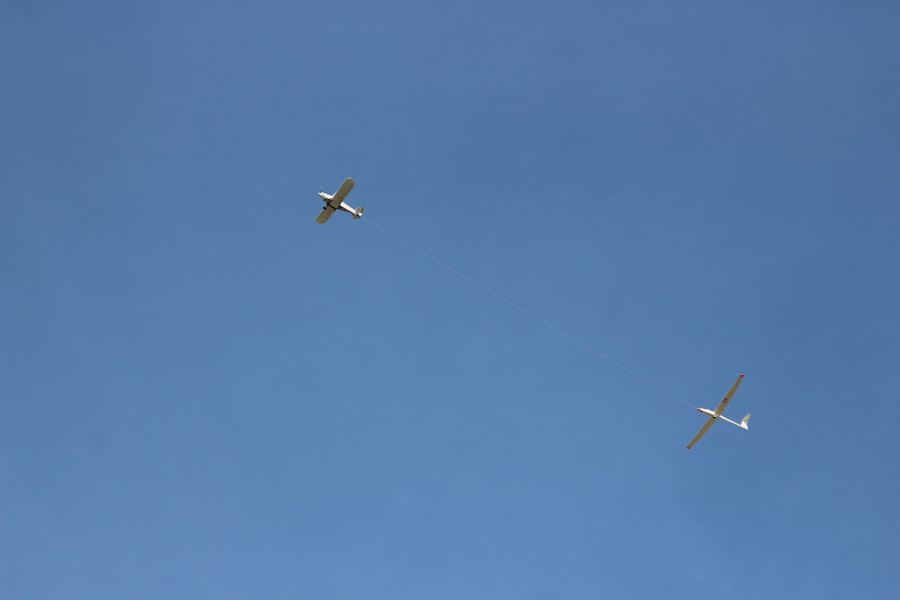The history of glider flying is a fascinating journey that intertwines human ingenuity with the quest for flight. The concept of soaring through the skies without the roar of an engine can be traced back to ancient civilizations, where myths and legends often depicted humans attempting to fly. However, it wasn’t until the late 19th and early 20th centuries that serious experimentation began.
Pioneers like Otto Lilienthal, often referred to as the “father of modern aviation,” made significant strides in glider design. His meticulously crafted gliders, which he tested over 2,000 flights, demonstrated the principles of lift and control, laying the groundwork for future aviators. As the 20th century progressed, glider technology evolved rapidly.
The advent of World War I saw military interest in unpowered flight, leading to advancements in aerodynamics and materials. Post-war, the gliding movement gained momentum, particularly in Europe and the United States. Organizations such as the Soaring Society of America were established to promote the sport and encourage safe flying practices.
The 1930s marked a golden age for gliding, with competitions and records being set, including the first official world gliding championships in 1937. This era not only showcased the capabilities of gliders but also highlighted the growing community of enthusiasts dedicated to the art of soaring.
Key Takeaways
- Glider flying has a rich history dating back to the late 19th century, with pioneers like Otto Lilienthal and the Wright brothers making significant contributions to its development.
- The basics of glider design and construction involve understanding aerodynamics, materials, and structural engineering to create a lightweight and efficient aircraft.
- Understanding the principles of glider flight includes knowledge of lift, drag, weight, and thrust, as well as how weather conditions and air currents affect glider performance.
- Preparing for a glider flight requires thorough safety training, including learning emergency procedures and understanding the importance of proper equipment maintenance.
- The thrill of glider flying offers a unique experience of freedom in the skies, allowing pilots to soar without the noise and reliance on engines, and to connect with nature in a profound way.
The Basics of Glider Design and Construction
Glider design is a complex interplay of aerodynamics, materials science, and engineering principles. At its core, a glider is designed to maximize lift while minimizing drag, allowing it to soar gracefully through the air. The wings of a glider are typically long and slender, a design choice that enhances lift-to-drag ratios.
This aerodynamic efficiency is crucial for maintaining altitude and extending flight duration without an engine’s thrust. The aspect ratio, which is the ratio of wing span to wing chord, plays a significant role in determining a glider’s performance; higher aspect ratios generally lead to better soaring capabilities. Construction materials have also evolved significantly over time.
Early gliders were primarily made from wood and fabric, but modern gliders often utilize advanced composites such as carbon fiber and fiberglass. These materials not only reduce weight but also enhance structural integrity, allowing for sleeker designs that can withstand the stresses of flight. Additionally, advancements in computer-aided design (CAD) have enabled engineers to simulate aerodynamic performance before physical prototypes are built, leading to more efficient designs that push the boundaries of what is possible in glider performance.
Understanding the Principles of Glider Flight

To grasp the principles of glider flight, one must first understand the fundamental forces at play: lift, weight, thrust, and drag. In a powered aircraft, thrust generated by engines counteracts drag while lift counters weight. However, in a glider, thrust is absent; thus, pilots rely on lift generated by their wings to stay aloft.
Lift is produced when air flows over and under the wings, creating a pressure difference due to the wing’s shape (airfoil) and angle of attack. This principle is rooted in Bernoulli’s principle and Newton’s third law of motion. The concept of thermals—rising columns of warm air—is vital for glider pilots seeking to extend their flights.
By circling within these thermals, pilots can gain altitude without any engine power. Understanding how to identify and utilize thermals is a skill that separates novice pilots from seasoned ones. Additionally, ridge soaring takes advantage of wind deflected upward by terrain features such as hills or mountains.
Both techniques require keen observational skills and an understanding of meteorological conditions, making them essential components of successful glider flying.
Preparing for a Glider Flight: Safety and Training
| Training Topic | Safety Measure |
|---|---|
| Weather Conditions | Understanding wind patterns and cloud formations |
| Aircraft Inspection | Checking control surfaces, cables, and instruments |
| Emergency Procedures | Practicing rope break and landing without power |
| Flight Regulations | Learning airspace restrictions and right-of-way rules |
Preparation for a glider flight involves rigorous training and adherence to safety protocols. Aspiring pilots typically begin their journey with ground school, where they learn about aerodynamics, meteorology, navigation, and emergency procedures. This foundational knowledge is crucial for making informed decisions during flight.
Following ground school, students usually undergo flight training with certified instructors who provide hands-on experience in dual-controlled gliders. This mentorship is invaluable as it allows students to develop their flying skills under expert guidance. Safety is paramount in gliding; thus, pre-flight checks are an essential routine before every flight.
Pilots must inspect their gliders for structural integrity, control surface functionality, and overall readiness for flight. Weather conditions are also critically assessed; strong winds or adverse weather can significantly impact safety. Additionally, pilots are trained to handle emergencies such as equipment failure or unexpected weather changes.
This comprehensive approach to training ensures that pilots are well-prepared to navigate both routine flights and unforeseen challenges.
The Thrill of Glider Flying: Experiencing the Freedom of the Skies
The experience of glider flying is often described as one of unparalleled freedom and tranquility. Unlike powered flight, where noise and vibration can detract from the experience, gliding offers a serene connection with nature. As pilots ascend into the sky, they are enveloped by silence, punctuated only by the sound of wind rushing past the wings.
This unique auditory experience allows pilots to immerse themselves fully in their surroundings, observing landscapes from breathtaking heights. The thrill of soaring through the air is not just about the physical act of flying; it also encompasses a profound sense of achievement and mastery over one’s environment. Pilots often describe the exhilaration felt when they successfully catch a thermal or navigate complex air currents.
Each flight presents new challenges and opportunities for skill development, fostering a deep appreciation for both the art and science of gliding. The camaraderie among fellow pilots further enhances this experience; shared stories and collective learning create a vibrant community that celebrates the joys of soaring together.
Advanced Techniques and Skills for Glider Pilots

As pilots gain experience in gliding, they often seek to refine their skills through advanced techniques that enhance their flying capabilities. One such technique is cross-country soaring, which involves navigating long distances between waypoints using thermals and ridge lift. This requires not only exceptional piloting skills but also strategic planning and an understanding of meteorological patterns over larger areas.
Experienced cross-country pilots often utilize tools such as GPS devices and flight planning software to optimize their routes and maximize their soaring potential. Another advanced skill is aerobatics in gliders, which involves performing maneuvers such as loops, rolls, and spins without an engine’s power. While aerobatic flying requires a high level of proficiency and understanding of aircraft dynamics, it also adds an exhilarating dimension to gliding.
Pilots must be well-versed in safety protocols and emergency procedures specific to aerobatic maneuvers to ensure both their safety and that of their aircraft during these thrilling displays.
Exploring Glider Flying as a Competitive Sport
Glider flying has evolved into a competitive sport with various events that test pilots’ skills against one another in challenging conditions. Competitions range from local club events to international championships governed by organizations like the Fédération Aéronautique Internationale (FAI). Events typically include tasks such as distance flying, speed over a set course, or precision landings—all designed to showcase a pilot’s skill in navigating their glider effectively.
Competitors must not only demonstrate exceptional flying abilities but also strategic thinking and teamwork when flying in groups or teams. The competitive environment fosters camaraderie among participants while pushing each pilot to improve their skills continually. Many pilots find that competition enhances their understanding of meteorology and aerodynamics as they analyze performance data post-flight to refine their techniques for future events.
The Future of Glider Flying: Innovations and Advancements
The future of glider flying is poised for exciting innovations driven by advancements in technology and materials science. One notable trend is the integration of electric propulsion systems into gliders, allowing for enhanced launch capabilities without relying solely on tow planes or winches. These electric systems can provide additional thrust during critical phases of flight while still allowing pilots to experience the joys of soaring without engine noise.
Moreover, developments in artificial intelligence (AI) are beginning to influence how pilots plan their flights and interact with their aircraft systems. AI can assist in real-time weather analysis and optimize flight paths based on current atmospheric conditions, enhancing safety and performance during flights. Additionally, advancements in lightweight materials continue to push the boundaries of glider design, enabling even more efficient shapes that maximize lift while minimizing drag.
As interest in sustainable aviation grows globally, gliding stands out as an environmentally friendly alternative to powered flight. The emphasis on reducing carbon footprints aligns well with the principles of soaring—using natural energy sources like thermals and ridge lift rather than fossil fuels. This focus on sustainability may attract new enthusiasts to the sport while encouraging existing pilots to embrace innovative practices that further enhance their connection with nature through unpowered flight experiences.


